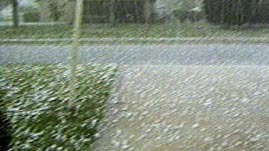Teachers' Domain - Digital Media for the Classroom and Professional Development
User: Preview

Source: Produced for Teachers' Domain
Water that falls from the sky is called precipitation. As one aspect of weather, precipitation such as rain or snow can affect your daily life. However, it is also a vital step in the water cycle, returning water from the atmosphere back to Earth's surface. In this video segment produced for Teachers' Domain, observe three different types of precipitation — rain, hail, and snow.
The water cycle — the continuous exchange of water between Earth's surface and atmosphere — is Earth's natural mechanism for recycling water. Liquid water on Earth's surface evaporates to become water vapor in the atmosphere; the water vapor produces clouds and precipitation; and the precipitation returns water to the surface.
Clouds are collections of billions of water droplets or ice crystals. When a mass of air is saturated with water and the temperature remains above 0°C (32°F), the water vapor condenses around particles in the air to form tiny droplets of water. If the temperature is below 0°C (32°F), water vapor is directly deposited as ice crystals. When the water droplets or ice crystals become too heavy to remain suspended in the atmosphere, they fall to Earth's surface as precipitation.
The two main forms of precipitation — rain and snow — can appear in many variations, including freezing rain, sleet, and hail. The type of precipitation that falls depends on the temperature of the air — both where the precipitation forms and through which it falls. When the air temperature is above 0°C (32°F), the precipitation falls as rain because the water stays in liquid form. When the air temperature is below 0°C (32°F), snow — crystalline flakes of frozen water — falls. Snowflakes take time to melt, so they can survive passing through a thin layer of air above 0°C (32°F), and snow can fall even when the air at ground level is warm. On the other hand, if rain — or snow that passed through a large enough warm layer that it melted — has to pass through a layer of freezing air near the ground, it may turn into sleet or freezing rain. Sleet is made up of drops of water that freeze near the ground, and freezing rain is made up of supercooled drops that freeze upon impact with surfaces below 0°C (32°F).
Hail — lumps of ice that can become as large as baseballs — forms in severe thunderstorm clouds that contain both rain and snow. As a snowflake falls through the cloud, water freezes around it and the pellet grows larger in size. Strong updrafts in the cloud then toss the frozen lump back up towards the top of the storm. As it falls through the cloud again, more layers of ice may be added. This may happen again and again, and it continues until the hailstone becomes too massive to be supported by the updraft and falls to the ground.
 Loading Standards
Loading Standards Teachers' Domain is proud to be a Pathways portal to the National Science Digital Library.
Teachers' Domain is proud to be a Pathways portal to the National Science Digital Library.
